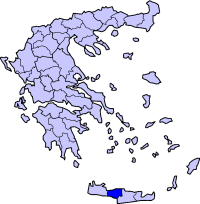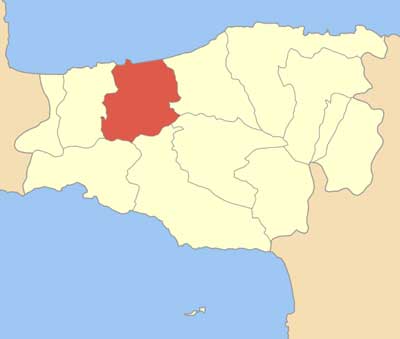.


Roussospiti (Ρουσσοσπίτι) is a local community of the Rethymno Municipality in the Rethymno (regional unit) of the region of Crete established by Kallikratis reform. Previously, it was part of the former municipality of Rethymno. Capital of the new municipality is Rethymnon. It is a traditional settlement and is classified in Class II, that is of average cultural value (Government Gazette 728/21-9-1995) [1].
Geography, origin of name, history
It is located 9 km southeast of Rethymno at an altitude of 300 meters [2], built in the 12th century by Venetians, as evidenced by the Venetian buildings in the village (arches, gates, fountain). At that time, a house ("spiti", in Greek) was built in the village, and this was called "Russo", i.e. red (russo+spiti=red house), and the village took its name after that. Others say that a Russian (Roussa) woman had built a house in the village, and that could be the origin of its name (the house of the Russian =roussospiti). 157 inhabitants were recorded in 1583. Later on, its was occupied my the Ottomans [3] The village lies on the slope of Vrisinas at an altitude of 300 meters. Apart from many Venetian houses, there is also a fountain of the 17th century and the church of Virgin Mary in this settlement. You can enjoy magnificent sea view (to the north) [4]
Population of Roussospiti [5]
1913 1920 1928 1940 1951 1961 1971 1981 1991 2001
372 400 358 358 353 272 195 174 257 374
Attractions: Monuments, Temples, important buildings
The Virgin Mary is a small one-room church, like most churches of Crete. Built in the early 14th century. The Christ of the Crucifixion is one of the best preserved frescoes of the church and one of the most dynamic forms of Cretan art.
The Fountain of Roussospiti: It dates back to the 17th century. Gerola described it as "graceful", a characterisation, which, on a closer look, one must agree with. The spout has the shape of a lion's head. [6]
Monastery of Aghia Irini (Saint Eirene), is situated near Roussospiti. This very old monastery is considered to date back to the 14th century. After restoration works were started in 1989, the monastery was given new life due to the eager activities of the nuns. [7] [8]. There is an ecclisiastical museum in the Monastery area, called Holy Trinity Ecclisiastical museum of Agia Irini [9].
Michellaneous
The village celebrates Agia Paraskevi’s name day (26 July)
See also
List of settlements in the Rethymno regional unit
External links
Photo Gallery, Web site of municipality of Rethymnno retrieved at 11 April 2012
title Cycling routes, Web site of municipality of Rethymnno, retrieved at 11 Arpil 2012
Route:Rethymno - Aghia Irini - Roussospiti - Chromonastiri - Myli - Rethymno, Tourism Promotion Committee of Rethymno Prefecture retrieved at 11 April 2012
References
^ Antonogiannakis Michael, The Vrisinas, The Mount Rethemnous, topographic, geographic, historical, social and folkloric perspective, Athens 2010 (in greek), p 382
^ Papyrus Larousse Britannica, Athens, 1996
^ "Ottoman Settlements". Institute for Mediterranean Studies, Digital Crete. Retrieved 11 April 2012.
^ Presentation and pictures of Roussospiti at Web site of Rethymno municipality (in greek)retrieved at 11 April 2012
^ Hellenic Statistical Authority, Digital Library (ELSAT), Census (Greek and English)
^ "Public Buildings, Roussospiti Fountain". Tourism Promotion Committee of Rethymno Prefecture. Retrieved 11 April 2012.
^ "Monastery of Agia Irini". Tourism Promotion Committee of Rethymno Prefecture. Retrieved 11 April 2012.
^ Agia Eirene "Ottoman Settlements". Institute for Mediterranean Studies, Digital Crete. Retrieved 11 April 2012.
^ "Museums". Institute for Mediterranean Studies, Digital Crete. Retrieved 11 April 2012.
| Municipal unit Rethymno |
|---|
| Municipal Community Rethymno |
| Agia Eirini (Αγία Ειρήνη) |
| Anogeia (Ανώγεια, τα) |
| Gallos (Γάλλος, ο) |
| Giannoudi (Γιαννούδιον, το) |
| Μεγάλο Μετόχι, το |
| Mikro Metochi (Μικρό Μετόχι, το) |
| Ξηρόν Χωρίον, το |
| Rethymno (Ρέθυμνον, το) |
| Tria Monastiria (Τρία Μοναστήρια, τα) |
| Community Armenoi |
| Άγιος Γεώργιος, ο |
| Armenoi (Αρμένοι, οι) |
| Somatas (Σωματάς, ο) |
| Foteinos (Φωτεινός, ο) |
| Community Goulediana |
| Γενή, η |
| Goulediana (Γουλεδιανά, τα) |
| Community Kare |
| Ampelaki (Αμπελάκι, το) |
| Kare (Καρέ) |
| Community Kastellos |
| Kastellos (Κάστελλος, ο) |
| Community Koumes |
| Koumoi (Κούμοι, οι) |
| Community Maroulas |
| Dilofo (Δίλοφο, το) |
| Maroulas (Μαρουλάς, ο) |
| Community Oros |
| Oros (Όρος, το) |
| Community Prasies |
| Prasies (Πρασιαί, αι) |
| Community Roussospiti |
| Roussospiti (Ρουσσοσπίτιον, το) |
| Community Selli |
| Μύρθιος, η |
| Σελλίον, το |
| Community Chromonastiri |
| Kapediana (Καπεδιανά, τα) |
| Myloi (Μύλοι, οι) |
| Prinedes (Πρινέδες, οι) |
| Chromonastiri (Χρομοναστήριον, το) |
Greece :
A - B - C - D - E - F - G - H - I - J - K - L - M -
N - O - P - Q - R - S - T - U - V - W - X - Y - Z
| Ancient Greece
Science, Technology , Medicine , Warfare, , Biographies , Life , Cities/Places/Maps , Arts , Literature , Philosophy ,Olympics, Mythology , History , Images Medieval Greece / Byzantine Empire Science, Technology, Arts, , Warfare , Literature, Biographies, Icons, History Modern Greece Cities, Islands, Regions, Fauna/Flora ,Biographies , History , Warfare, Science/Technology, Literature, Music , Arts , Film/Actors , Sport , Fashion --- |
Retrieved from "http://en.wikipedia.org/"
All text is available under the terms of the GNU Free Documentation License


